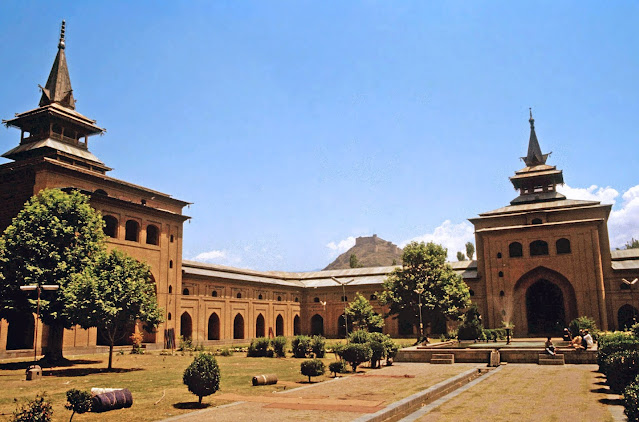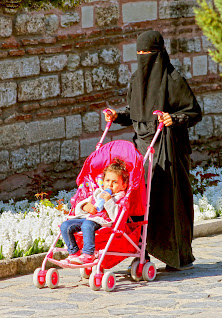 |
| Houseboats & shikara, Lake Dal, Srinagar |
Day 16 Tue
10 June JAMMU – SRINAGAR
Departure time: 8am Tach reading: 134,299 Distance run: 280kms
Today we drive back into the mountains,
this time the western Himalayas. The distance between Jammu and Srinagar is a little under 300kms, but it will take us around 10 hours as we have two passes to drive over on very winding tortuous roads. The first takes us to the town of Kud, the second and highest, the Banihal Pass, is at an elevation of over 8000 feet and culminates in a tunnel, the other side of which we have our first views of the fabled Vale of Kashmir. As we wind our way up to the Banihal Pass, take note of the road safety signs by the road - 'Keep Your Nerve on Sharp Curves'; 'Better Late than the Late'; 'Be Gentle on My Curves'; 'Death Lays His Icy Hands on Speed King'; 'This is Not a Race or a Rally, Drive Slow and Enjoy Kashmir Valley', but the classic is 'Darling, Don't Nag While I am Negotiating these Curves'.
 |
| Chenab River from the road |
 |
| Signs in the forest at Batote |
The Vale of Kashmir, a large Valley in the mountains, was, like the Kathmandu Valley, once a vast lake trapped by the uplifting Himalayas. Most of the waters have since drained away, although several smaller lakes have remained of which the best known is Lake Dal It is on this lake that the majority of the houseboats are found. The houseboats stem from the days of the British who came here during the Indian summer to escape the heat of the plains. The Maharajah of Kashmir would not sell land to the British, so the British built the houseboats, thus being able to live in Srinagar without owning any land. The houseboats we will be occupying on Lake Dal during our stay are Pandora, New Titwillow, Lotus, Golden Bell, Sunflower and Young Ceylon.
Day 17 Wed 11 June SRINAGAR
This morning half the group will be taken on an excursion to the old city which, to me, is somewhat reminiscent of Kathmandu. The old city is built along both banks of the Jhelum River, one of the 5 rivers of the Punjab. The city has two important Moslem mosques, both of a rather unique architecture which is not found elsewhere. In the old city, you will be taken to a carpet-weaving factory, leather, fur and embroidery shops. The rest of the group will go by shikara (the gondola-like water taxis), through some of the picturesque back canals of Srinagar to a wood-carving and papier-mâché shop. The canal tour, in particular, offers some good opportunities for photography.
 |
| Shikaras on Lake Dal, Srinagar |
 |
| Never too young to paddle a shikara! |
 |
| Old man poling logs in canals of Srinagar |
 |
| Kashmiri girls in a window, Srinagar |
In the afternoon, those who went by shikara will go to the old city, and vice versa.
Pax comments:
“HOW TO GET ONTO A HOUSEBOAT IN 5 EASY STEPS”
(NB. PAULINE HAS APPLIED FOR A PATENT)
(NB. PAULINE HAS APPLIED FOR A PATENT)
Day 18 Thu 12 June SRINAGAR
A free day. There is an excursion arranged to Gulmarg – the ‘meadow of flowers’ – situated in the mountains near the Pakistan border. The world’s highest golf club is situated here and horse-riding, trekking or an excursion on the chairlifts are available. Gulmarg is about 55kms from Srinagar.
Other options include a visit to the Moghul gardens on Lake Dal, about an hour’s journey by shikara at a cost of 10 rupees return. Swimming and water-skiing are also available here.
The old town of Srinagar with its wooden buildings is a fascinating place to explore. The large Jamia Mosque dates from 1400 and is a classic example of the Indo--Saracenic style of architecture. It boasts a large courtyard. The mosque interior is supported by 370 wooden pillars. The Hari Parbat Fort, originally begun by Moghul Emperor Akbar but not completed until 1808, overlooks the town and is still partly occupied by the Indian military, so access is restricted. but the views of the Valley from here are great.
 |
| Tomb of Zain ul-Abidin |
In the narrow streets of the old city is the tomb of the 15th century ruler Zain ul-Abidin, now fallen into disrepair, and another interesting tomb known as Roza Bal. Many Kashmiris claim that the Roza Bal is actually the tomb of Jesus. They base their rather tenuous evidence on a loose interpretation of a passage in the Koran - verse 23:50 which states: ‘And We made the son of Mary and his mother a potent, and We gave them refuge on a height, a place of flocks and water-springs’ (Mohammed Marmaduke Pickthall – The Meaning of the Glorious Koran) which is claimed to be a reference to Kashmir. A local historian, Aziz Kashmiri, in his book Christ in Kashmir writes: ‘Sir Mohd Zaferullah Khan a judge of International Court of Justice in a statement on 29th Oct. 1967 at Toronto (Canada) stated that Jesus did not die on the cross but had fainted. Thereafter he had migrated from Palestine to Kashmir where he then preached up to his last and he died and was buried there.’ The local belief is that Jesus was 120 when he passed on! I was also told that the person intered was above normal statue and height and that the tomb did not face Mecca, as Moslem tombs should do, but faced towards Jerusalem!
 |
| Street scene in old Srinagar |
 |
| The Jamia Masjid, the largest mosque in Srinagar |
 |
| The Hari Parbat Fort overlooking Srinagar and Lake Dal |
Day 19 Fri 13 June SRINAGAR
 |
| Shankarachariya Hindu Temple |
Over the last couple of days, you all have probably noticed women going about completely veiled. This garment is known as the chadori, and when women wear this tent-like garment and live in a special women’s quarter at home, it is known as purdah. Strangely enough, the Koran (Islamic Holy Book) says nothing about the veil or about women living in seclusion, so it appears that purdah is of secular origin. Originally purdah was observed only by royalty, the nobility, up-class and affluent business families and this caused the wearing of the chadori to become a significant status symbol. Lower classes or peasants did not practice purdah.
The Mullahs, or
Islamic priests, encouraged purdah, ostensibly in the name of decency but, opponents say, in reality to make the women feel inferior, both physically and psychologically, thus the prestige of the mullah is strongest where conservatism is maintained. The wearing of the veil has been rapidly diminishing (1980) in many Moslem countries, although religious leaders, such as the Ayatollah Khomeini, have encouraged its use, with limited success. You will see women wearing the chadori in most of the Moslem countries we visit.
 |
| Woman wearing the chadori |
The Moghul Emperor Jahangir was a great fan of Kashmir. In his Memoirs, Tuzuk-i-Jahangiri, he waxed lyrical: "Kashmir is a garden of eternal spring, or an iron fort to a palace of kings - a delightful flower-bed, and a heart-expanding heritage for dervishes. Its pleasant meads and enchanting cascades are beyond all description. There are running streams and fountains beyond count. Wherever the eye reaches, there are verdure and running water. The red rose, the violet, and the narcissus grow of themselves; in the fields, there are all kinds of flowers and all sorts of street-scented herbs more than can be calculated. In the soul-enchanting spring the hills and plains are filled with blossoms; the gates, the walls, the courts, the roofs, are lighted up by the torches of banquet-adorning tulips."
Day 20 Sat 14 June SRINAGAR – JAMMU
DEPARTURE TIME: 8am Tach reading: 134,579 Distance run: 277 kms
From Srinagar we retrace our steps back over the Banihal Pass, through the small towns of Batote, Kud and the larger military city of Udhampur to Jammu, the winter capital of the Dogra Maharajahs of Jammu & Kashmir, and once more into the heat of the Indian plains. The Dogras ruled Jammu & Kashmir from 1846 until after Independence in 1947. In fact it was the last Maharajah, Hari Singh's hesitancy to join with either India, Pakistan or to stay independent that led to the impromptu invasion of Pathan tribesmen from Pakistan. Hari Singh requested assistance from India, and this was the genesis of the "Kashmir Problem' which has created conflict between the two nations ever since. Amar Mahal, on the edge of town, was one of the last palaces built in India and although French-designed, was not built until the 1890s, in the style of a Eurpoean Castle. It is now a Museum of rare books and works of art.
 |
| The French-designed 19th century Amar Mahal, last palace of the Dogra Maharajahs of Jammu & Kashmir |
Our overnight stop will once again be at the Jammu Motel.
text & photographs ©Neil Rawlins |





No comments:
Post a Comment